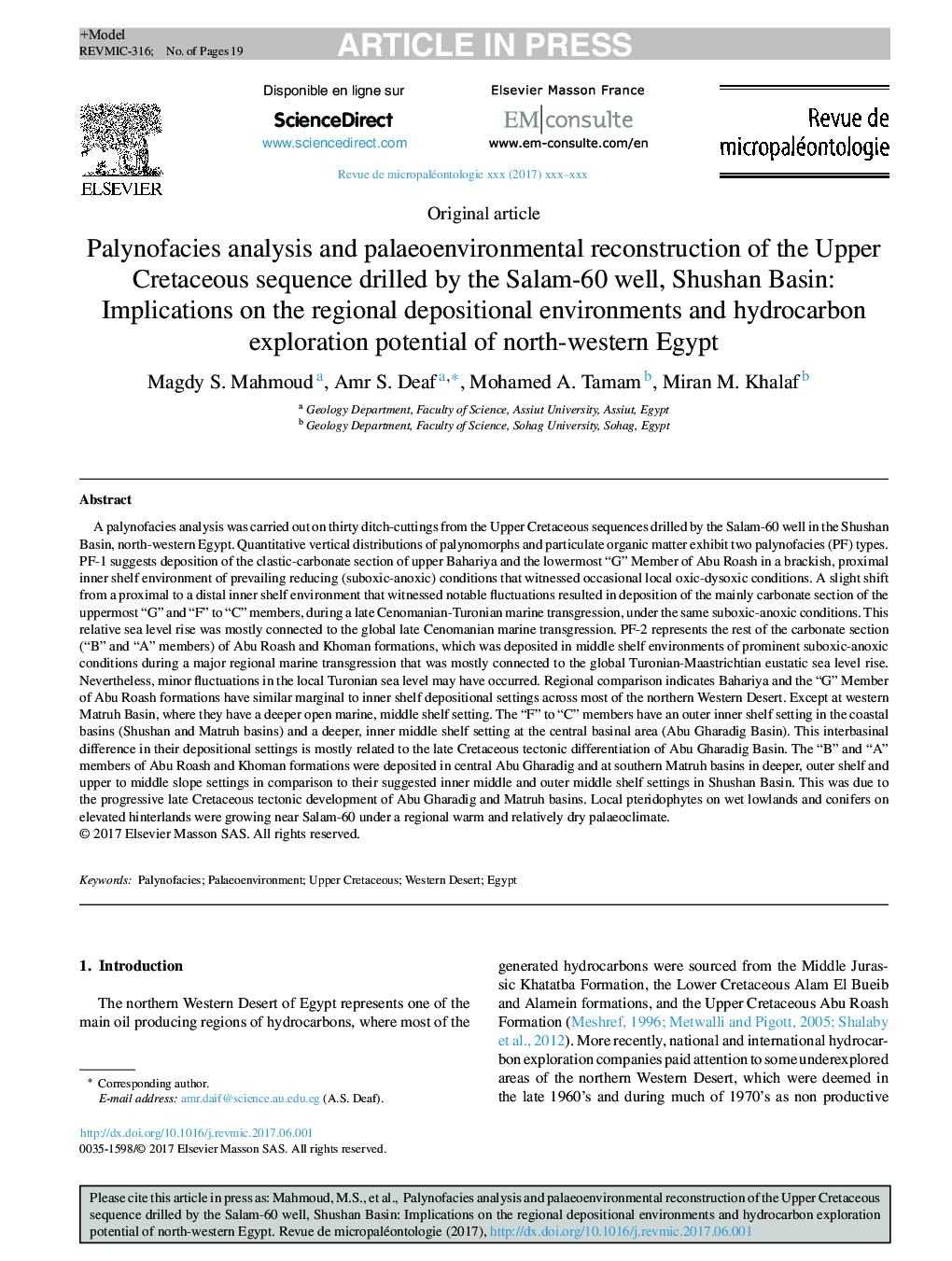| کد مقاله | کد نشریه | سال انتشار | مقاله انگلیسی | نسخه تمام متن |
|---|---|---|---|---|
| 8916674 | 1642659 | 2017 | 19 صفحه PDF | دانلود رایگان |
عنوان انگلیسی مقاله ISI
Palynofacies analysis and palaeoenvironmental reconstruction of the Upper Cretaceous sequence drilled by the Salam-60 well, Shushan Basin: Implications on the regional depositional environments and hydrocarbon exploration potential of north-western Egypt
دانلود مقاله + سفارش ترجمه
دانلود مقاله ISI انگلیسی
رایگان برای ایرانیان
کلمات کلیدی
موضوعات مرتبط
مهندسی و علوم پایه
علوم زمین و سیارات
فسیل شناسی
پیش نمایش صفحه اول مقاله

چکیده انگلیسی
A palynofacies analysis was carried out on thirty ditch-cuttings from the Upper Cretaceous sequences drilled by the Salam-60 well in the Shushan Basin, north-western Egypt. Quantitative vertical distributions of palynomorphs and particulate organic matter exhibit two palynofacies (PF) types. PF-1 suggests deposition of the clastic-carbonate section of upper Bahariya and the lowermost “G” Member of Abu Roash in a brackish, proximal inner shelf environment of prevailing reducing (suboxic-anoxic) conditions that witnessed occasional local oxic-dysoxic conditions. A slight shift from a proximal to a distal inner shelf environment that witnessed notable fluctuations resulted in deposition of the mainly carbonate section of the uppermost “G” and “F” to “C” members, during a late Cenomanian-Turonian marine transgression, under the same suboxic-anoxic conditions. This relative sea level rise was mostly connected to the global late Cenomanian marine transgression. PF-2 represents the rest of the carbonate section (“B” and “A” members) of Abu Roash and Khoman formations, which was deposited in middle shelf environments of prominent suboxic-anoxic conditions during a major regional marine transgression that was mostly connected to the global Turonian-Maastrichtian eustatic sea level rise. Nevertheless, minor fluctuations in the local Turonian sea level may have occurred. Regional comparison indicates Bahariya and the “G” Member of Abu Roash formations have similar marginal to inner shelf depositional settings across most of the northern Western Desert. Except at western Matruh Basin, where they have a deeper open marine, middle shelf setting. The “F” to “C” members have an outer inner shelf setting in the coastal basins (Shushan and Matruh basins) and a deeper, inner middle shelf setting at the central basinal area (Abu Gharadig Basin). This interbasinal difference in their depositional settings is mostly related to the late Cretaceous tectonic differentiation of Abu Gharadig Basin. The “B” and “A” members of Abu Roash and Khoman formations were deposited in central Abu Gharadig and at southern Matruh basins in deeper, outer shelf and upper to middle slope settings in comparison to their suggested inner middle and outer middle shelf settings in Shushan Basin. This was due to the progressive late Cretaceous tectonic development of Abu Gharadig and Matruh basins. Local pteridophytes on wet lowlands and conifers on elevated hinterlands were growing near Salam-60 under a regional warm and relatively dry palaeoclimate.
ناشر
Database: Elsevier - ScienceDirect (ساینس دایرکت)
Journal: Revue de Micropaléontologie - Volume 60, Issue 4, OctoberâDecember 2017, Pages 449-467
Journal: Revue de Micropaléontologie - Volume 60, Issue 4, OctoberâDecember 2017, Pages 449-467
نویسندگان
Magdy S. Mahmoud, Amr S. Deaf, Mohamed A. Tamam, Miran M. Khalaf,